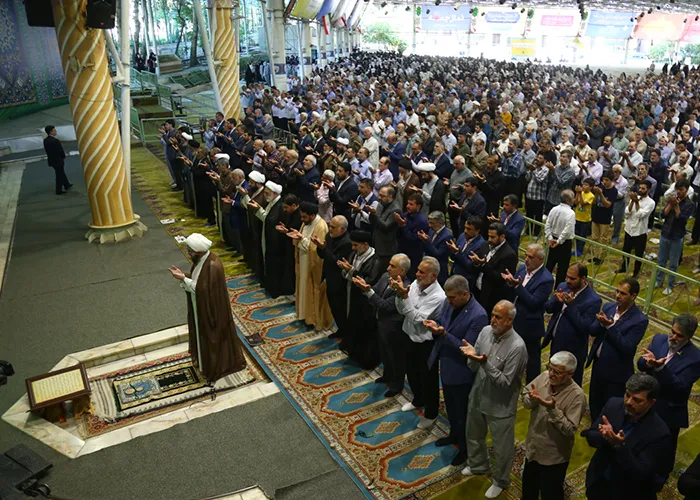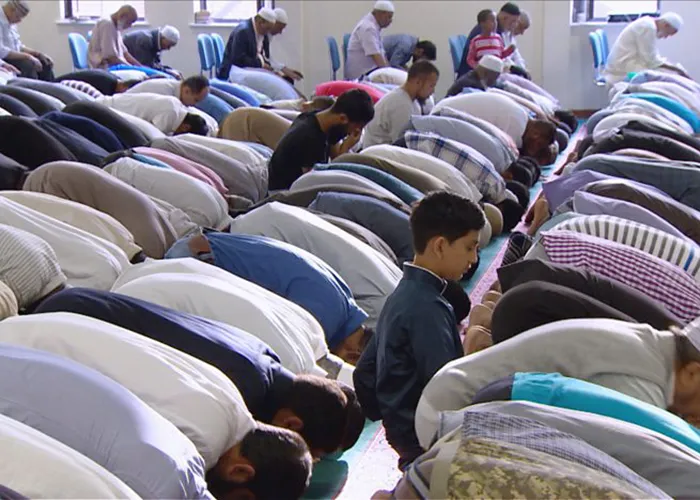Fatwa Panel of the Week – Volume02 Issue23
Topic: Rulings of Eid Prayers (Eid al-Fitr & Eid al-Adha)
Eid of Worship and Unity
Eid al-Fitr and Eid al-Adha are two grand Islamic festivals that manifest gratitude, servitude, and unity. The Eid prayer is a highly recommended collective act of worship that strengthens community bonds. Knowing its rulings helps us perform it properly and benefit spiritually.
In this section, we will cover the most important rulings of the Eid al-Fitr and Eid al-Adha prayers based on the fatwas of the Grand Marājiʿ: Ayatollah Sayyid Ali Khamenei, Ayatollah Sayyid Ali Sistani, and Ayatollah Naser Makarem Shirazi.
How should we perform the Eid prayer?
- Ruling and Timing of the Eid al-Fitr and Eid al-Adha Prayers
| Ruling and Timing of Eid Prayers | Ayatollah Khamenei | Ayatollah Sistani | Ayatollah Makarem Shirazi |
| Ruling during Occultation | The Eid al-Fitr and Eid al-Adha prayers are obligatory during the time of the presence of the Imam (peace be upon him) and must be performed in congregation. However, in our time, when the Imam (peace be upon him) is in occultation, the prayer is recommended (mustahabb). | Same as Khamenei | Same as Khamenei |
| Time of Prayer | From sunrise until noon. | Same ruling. | Same ruling. |
- How to Perform the Eid Prayer
The Eid prayers of al-Fitr and al-Adha consist of two rak‘ahs and do not require adhan or iqamah.
| Prayer Steps
|
First Rakʿah | Second Rakʿah | ||
| After Ḥamd and Sūrah | Say 5 takbīrs, and after each takbīr, recite a qunūt. After the fifth qunūt, say another takbīr and go to rukūʿ. (According to Ayatollah Khamenei and Ayatollah Makarem Shirazi) | Say 4 takbīrs, and after each takbīr, recite a qunūt. After the fourth qunūt, say another takbīr and go to rukūʿ. (According to Ayatollah Khamenei and Ayatollah Makarem Shirazi) | ||
| Continuing the Prayer |
|
After rukūʿ, perform two sujūd, then recite tashahhud and salām. (Consensus) |
Ayatollah Sistani: According to obligatory precaution, the required number of takbīrs and qunūts in each rakʿah is three takbīrs with two qunūts between them, and an additional takbīr before rukūʿ as a matter of precaution-making it four takbīrs in total per rakʿah.
However, it is recommended to say five takbīrs with four qunūts in the first rakʿah, and four takbīrs with three qunūts in the second rakʿah. In this case too, one more takbīr before rukūʿ is required as a matter of precaution.
Content of Qunūt:
In the qunūt of the Eid prayers (al-Fitr and al-Adha), any duʿāʾ or dhikr may be recited and it will be sufficient. However, it is recommended, with the hope of attaining reward, to recite the following supplication:
«اللّهُمَّ اَهْلَ الْکِبْرِیاءِ وَ الْعَظِمَة وَ اَهْلَ الْجُودِ وَ الْجَبَرُوتِ وَ اَهْلَ الْعَفْوِ وَ الرَّحْمَةِ وَ اَهْلَ التَّقْوى وَ الْمَغْفِرَةِ اَسْئَلُکَ بِحَقِّ هذَا الْیَوْمِ الَّذِى جَعَلْتَهُ لِلْمُسْلِمینَ عیداً وَ لِمحَمَّد صَلَّى اللّهُ عَلَیْهِ وَ آلِهِ ذُخْراً وَ شَرَفاً وَ کَرامَةً وَ مَزیداً اَنْ تُصَلِّىَ عَلى مُحَمَّد وَ آلِ مُحَمَّد وَ اَنْ تُدْخِلَنی فى کُلِّ خَیْر اَدْخَلْتَ فیهِ مُحَمَّداً وَ آلَ مُحَمَّد وَ اَنْ تُخْرِجَنی مِنْ کُلِّ سُوء اَخْرَجْتَ مِنْهُ مُحَمَّداً وَ آلَ مُحَمَّد صَلَواتُکَ عَلَیْهِ وَ عَلَیْهِمْ اَللّهُمَّ اِنّى اَسْئَلُکَ خَیْرَ ما سَئَلَکَ بِهِ عِبادُکَ الصّالِحُونَ وَ اَعُوذُ بِکَ مِمّا اسْتَعاذَ مِنْهُ عِبادُکَ الْمـُخْلَصُونَ». (Consensus)
- Recommended (Mustahabb) Acts for Eid prayer
| Subject | Ayatollah Khamenei | Ayatollah Sistani | Ayatollah Makarem Shirazi |
| Ghusl (ritual bath) | _ | Recommended to walk to Eid prayer barefoot, with dignity, perform ghusl before prayer, and wear a white turban. | Recommended to perform ghusl before the Eid prayer and recite the duʿās mentioned in the books before and after prayer. |
| Takbīrāt | – | After Maghrib and ‘Ishāʾ prayers on the night of Eid al-Fitr, and after Fajr and Eid prayer, it is recommended to recite: «الله اَکبَرُ، الله اَکبَرُ، لا اِلهَ اِلاَّ الله وَالله اَکبَرُ، الله اَکبَرُ وَلله الحَمْدُ، الله اَکبَرُ عَلی ما هَدانا». |
After Maghrib and ‘Ishāʾ on the night of Eid al-Fitr and after Fajr, Ẓuhr, ʿAṣr, and Eid prayer, recite the same takbīrāt. |
| Ḥamd & Sūrah Recitation | Sūrah should be recited aloud (jahr). | Same as Khamenei | Same as Khamenei |
| Khutbahs (sermons) | – | During the Imam’s occultation, if the Eid prayer is performed in congregation, two sermons should be delivered afterward. The imam should sit briefly between them. It is recommended to discuss zakāt al-fiṭrah in the Fitr khutbah and ritual sacrifice in the Adhā khutbah. | Two sermons should be delivered after the prayer (unlike Jumuʿah prayer where khutbah is before). Only applies if done in congregation. |
| Preferred Sūrahs | No specific Sūrah is required, but recommended to recite: Rakʿah 1: ash-Shams, Rakʿah 2: al-Ghāshiyah Or: Rakʿah 1: al-Aʿlā, Rakʿah 2: ash-Shams |
Same as Khamenei | No specific Sūrah is required, but recommended to recite: Rakʿah 1: al-Aʿlā, Rakʿah 2: ash-Shams, |
| Iftar & Sacrifice | – | – | On Eid al-Fitr, it is recommended to break the fast with dates before the prayer. On Eid al-Adha, it is recommended to eat from the sacrificial meat after prayer. |
| Clothing & Attendance | – | Recommended to wear clean clothes, use fragrance, walk barefoot and with dignity to the prayer, and wear a white turban. | – |
| Prayer Timing | On Eid al-Adha, it is recommended to pray after sunrise. On Eid al-Fitr, it is recommended to break the fast after sunrise, give zakāt al-fiṭrah, and then perform the prayer. |
Same as Khamenei. | Same as Khamenei. |
| Place of Prayer | – | It is recommended to perform the prayer in an open field, but in Makkah, it should be in Masjid al-Ḥarām. | The prayer should be performed in an open space, not under a roof. |
- Miscellaneous Rulings and Important Points
- The Eid prayer has no adhan (call to prayer) or iqamah (second call). (Consensus)
- If one arrives at the prayer while the Imam is in rukūʿ (bowing), they can make the intention, say the first takbīr, and go into rukūʿ. (Consensus)
- In the Eid prayer, like other prayers, the follower (ma’mūm) must recite the parts of the prayer other than Surah al-Fātiḥah and another surah by themselves. (Consensus)
- Increasing or decreasing the length of qunūt (supplication):
- Ayatollah Khamenei: It is permissible to recite the qunūt in Eid prayers either briefly or lengthily, but increasing or decreasing the number of qunūts is not allowed.
- Doubt about the number of takbīrs in the prayer:
- Ayatollah Khamenei: If the prayer performer is doubtful about the number of takbīrs or qunūts, if he has not passed the place of the takbīr, he should rely on the lesser number, and if later it turns out he actually said them, it is not problematic.
- Ayatollah Makarem Shirazi: If one doubts the number of takbīrs or qunūts, as long as he has not passed the place, he should rely on the lesser number; if it later turns out he said them, there is no problem.
- Forgetting parts:
- Ayatollah Khamenei: If one forgets recitation, takbīrs, or qunūts, the prayer is valid; but if one forgets rukūʿ, two sujūd, or takbīrat al-ihrām, the prayer is invalid.
- Ayatollah Sistani: If one forgets one sujūd in Eid prayer, it is necessary to perform it after the prayer. Also, if anything happens that requires two sujūd of forgetfulness (sujūd sahw) as in daily prayers, then one must perform two sujūd sahw.
- Ayatollah Makarem Shirazi: If by forgetfulness one forgets recitation, takbīrs, or qunūts but remembers after going into rukūʿ, the prayer is valid.
- If one forgets one sujūd or tashahhud in Eid prayer, the obligatory precaution is to perform it after the prayer, and if anything occurs that requires sujūd sahw in daily prayers, the obligatory precaution is to perform sujūd sahw after the Eid prayer.
- Women and Eid prayer:
- Ayatollah Sistani: “The recommended precaution is that women avoid going to the Eid prayer, but this precaution does not apply to elderly women.”
- Ruling on making up Eid and Qurban prayers:
- Ayatollah Khamenei: The Eid al-Fitr and Eid al-Adha prayers do not have a qada’ (making up) ruling.
editor's pick
news via inbox
Subscribe to the newsletter.




